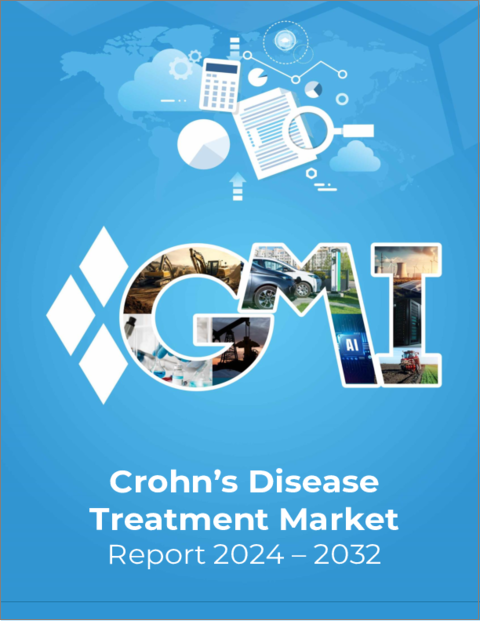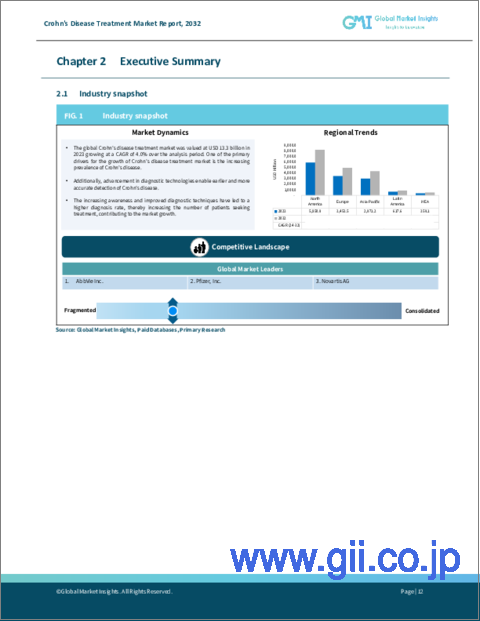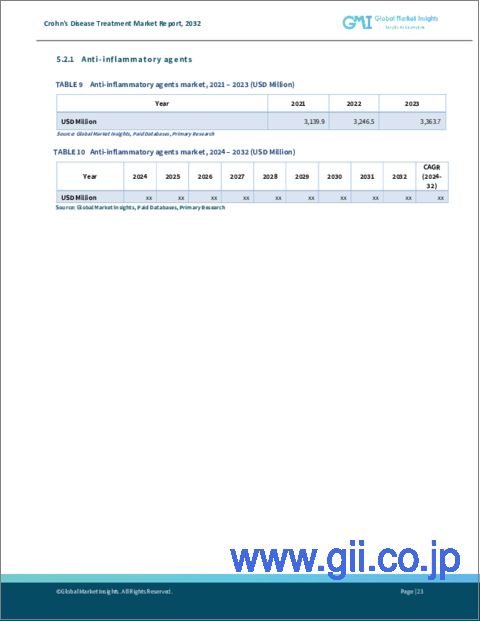|
|
市場調査レポート
商品コード
1535958
クローン病治療市場:治療、剤形、年齢層、最終用途別、世界予測、2024年~2032年Crohns Disease Treatment Market - By Treatment (Medication {Anti-inflammatory Agents, Immunosuppressants, Antibiotics, Antipyretics}, Nutritional Therapy, Surgery), Dosage Form (Oral, Parenteral), Age Group, End-use, Global Forecast 2024 - 2032 |
||||||
カスタマイズ可能
|
|||||||
| クローン病治療市場:治療、剤形、年齢層、最終用途別、世界予測、2024年~2032年 |
|
出版日: 2024年06月27日
発行: Global Market Insights Inc.
ページ情報: 英文 108 Pages
納期: 2~3営業日
|
全表示
- 概要
- 目次
クローン病治療市場は、炎症性腸疾患(IBD)の世界の有病率の増加を背景に、2024~2032年に4%のCAGRを記録すると予測されています。
クローン病・大腸炎財団の2023年ファクトシートによると、約160万~310万人の米国人がIBDに罹患しています。認知度の向上と診断の改善により、より多くの症例が確認されるようになり、効果的な治療に対する需要が高まっています。また、医学研究と技術の進歩により、新しい治療法や生物学的製剤が開発され、患者に希望をもたらしています。例えば、2024年7月、ステラーラ(ヤンセン・イミュノロジー社)の成分であるウステキヌマブttweが、重症乾癬、乾癬性関節炎、クローン病、潰瘍性大腸炎を含むすべての適応症でFDAから承認されました。
さらに、個別化医療への注目がクローン病の治療法を変えつつあります。クローン病の病態生理の解明が進むにつれて、治療は個々の遺伝子や分子プロファイルに合わせたものになりつつあります。このアプローチは治療効果と患者の転帰を改善し、市場成長をさらに促進します。
栄養療法分野は、症状の管理と患者の予後改善に重要な役割を果たすため、2032年まで大きな牽引力を持つであろう。栄養療法は、吸収不良の問題に対処し、適切な栄養状態を維持し、炎症を抑えるのに役立ちます。経腸栄養や除去食のようなカスタマイズされた食事計画は、寛解を誘発し薬理学的治療を補完する可能性があるとして、ますます認知されるようになっています。このアプローチは、全体的な健康と生活の質をサポートするだけでなく、副作用の可能性がある薬物への依存を軽減します。
小児部門は、疾患に対する認識の向上と早期診断の利点を背景に、2032年までに注目すべき市場シェアを占めるとみられます。小児患者のクローン病は、発育途上にある体にとって安全かつ効果的な治療法の必要性など、独特の課題を抱えています。研究の進歩により、年齢に応じた薬物療法や、成長と疾患管理の両方に対応する栄養介入など、小児に合わせた治療アプローチが確立されてきました。早期介入と個別ケアに重点が置かれるようになったことで、小児患者向けの専門的な治療とサポートサービスの需要が高まっています。
アジア太平洋地域のクローン病治療市場規模は2032年まで大幅に拡大します。これは、同地域全体における疾患有病率の増加、ヘルスケアインフラの改善、クローン病に対する認識の高まりが背景にあります。ヘルスケアへのアクセス拡大と医療技術への投資により、生物学的製剤や標的療法を含む先進的な治療オプションが利用しやすくなっています。さらに、この地域では研究開発への注目が高まっており、イノベーションが促進され、医療の質が向上しています。経済開拓が進み、ヘルスケアシステムが進化するにつれ、アジア太平洋市場は大きな成長を遂げようとしています。
目次
第1章 調査手法と調査範囲
第2章 エグゼクティブサマリー
第3章 業界洞察
- エコシステム分析
- 業界への影響要因
- 促進要因
- クローン病の有病率の増加
- 診断技術の進歩
- 医薬品開発のための研究開発活動の増加
- クローン病に対する意識の高まり
- 業界の潜在的リスク&課題
- 疾病管理の複雑さ
- 治療法の欠如
- 促進要因
- 成長可能性分析
- 規制状況
- パイプライン分析
- ポーター分析
- PESTEL分析
第4章 競合情勢
- イントロダクション
- 企業シェア分析
- 企業マトリックス分析
- 主要市場プレーヤーの競合分析
- 競合ポジショニングマトリックス
- 戦略ダッシュボード
第5章 市場推計・予測:治療別、2021年~2032年
- 主要動向
- 薬物療法
- 抗炎症薬
- 免疫抑制剤
- 抗生物質および解熱剤
- その他の薬物療法
- 栄養療法
- 外科手術
第6章 市場推計・予測:剤形別、2021年~2032年
- 主要動向
- 経口剤
- 非経口剤
第7章 市場推計・予測:年齢層別、2021年~2032年
- 主要動向
- 小児
- 成人
- 老年
第8章 市場推計・予測:最終用途別、2021年~2032年
- 主要動向
- 病院・診療所
- 在宅医療の現場
- その他のエンドユーザー
第9章 市場推計・予測:地域別、2021年~2032年
- 主要動向
- 北米
- 米国
- カナダ
- 欧州
- ドイツ
- 英国
- フランス
- スペイン
- イタリア
- オランダ
- その他欧州
- アジア太平洋
- 日本
- 中国
- インド
- オーストラリア
- 韓国
- その他アジア太平洋地域
- ラテンアメリカ
- ブラジル
- メキシコ
- その他ラテンアメリカ
- 中東・アフリカ
- 南アフリカ
- サウジアラビア
- アラブ首長国連邦
- その他中東とアフリカ
第10章 企業プロファイル
- AbbVie Inc.
- Amgen Inc.
- AstraZeneca Plc
- Biogen
- Boehringer Ingelheim GmbH
- Bristol Myerr Squibb
- Eli Lilly and Company
- Janssen Pharmaceuticals(Johnson & Johnson)
- Merck & Co. Inc
- Novartis AG
- Pfizer, Inc.
- Salix Pharmaceuticals, Inc.
- Takeda Pharmaceutical Industries Limited
- Viatris Inc.(Mylan N.V.)
Crohn's Disease Treatment Market is anticipated to record 4% CAGR during 2024-2032, backed by the increasing global prevalence of inflammatory bowel disease (IBD). According to the 2023 fact sheet by Crohn's & Colitis Foundation, around 1.6 to 3.1 million Americans are affected by IBD. Improved awareness and diagnostics are leading to more cases being identified, which boosts the demand for effective treatments. Advances in medical research and technology have also led to new therapies and biologics, offering hope for patients. For example, in July 2024, the FDA granted approval for ustekinumab-ttwe, a component of Stelara (Janssen Immunology), for all its indications, including severe psoriasis, psoriatic arthritis, Crohn's disease, and ulcerative colitis.
Additionally, the focus on personalized medicine is changing how Crohn's disease is treated. As the understanding of the disease's pathophysiology improves, treatments are becoming more tailored to individual genetic and molecular profiles. This approach improves treatment effectiveness and patient outcomes, further driving market growth.
The overall Crohn's disease treatment industry is classified based on treatment, dosage form, age group, end-use, and region.
The nutritional therapy segment will gain significant traction through 2032, due to its critical role in managing symptoms and improving patient outcomes. Nutritional therapy helps address malabsorption issues, maintain proper nutritional status, and reduce inflammation. Customized dietary plans, such as enteral nutrition and exclusion diets, are increasingly recognized for their potential to induce remission and complement pharmacological treatments. This approach not only supports overall health and quality of life but also reduces reliance on medications, which can have adverse effects.
The pediatric segment is poised to hold a notable market share by 2032, backed by the improved awareness of disease and benefits of early diagnosis. Crohn's disease in pediatric patients presents unique challenges, including the need for treatments that are safe and effective for a developing body. Advances in research have led to tailored therapeutic approaches for children, including age-appropriate medications and nutritional interventions that address both growth and disease management. The growing emphasis on early intervention and personalized care is driving the demand for specialized treatments and support services for pediatric patients.
Asia Pacific Crohn's disease treatment market size will expand substantially through 2032, driven by increasing disease prevalence, improved healthcare infrastructure, and rising awareness of Crohn's disease across the region. The expansion of healthcare access and investment in medical technology are facilitating the availability of advanced treatment options, including biologics and targeted therapies. Additionally, a growing focus on R&D within the region is fostering innovation and enhancing the quality of care. As economic development continues and healthcare systems evolve, the Asia Pacific market is poised for substantial growth.
Table of Contents
Chapter 1 Methodology & Scope
- 1.1 Market scope & definitions
- 1.2 Research design
- 1.2.1 Research approach
- 1.2.2 Data collection methods
- 1.3 Base estimates & calculations
- 1.3.1 Base year calculation
- 1.3.2 Key trends for market estimation
- 1.4 Forecast model
- 1.5 Primary research and validation
- 1.5.1 Primary sources
- 1.5.2 Data mining sources
Chapter 2 Executive Summary
- 2.1 Industry 360° synopsis
Chapter 3 Industry Insights
- 3.1 Industry ecosystem analysis
- 3.2 Industry impact forces
- 3.2.1 Growth drivers
- 3.2.1.1 Increasing prevalence of crohn's disease
- 3.2.1.2 Advancement in diagnostic techniques
- 3.2.1.3 Increasing research & development activities for drug development
- 3.2.1.4 Increased awareness about crohn's disease
- 3.2.2 Industry pitfalls & challenges
- 3.2.2.1 Complexity of disease management
- 3.2.2.2 Lack of curative treatments
- 3.2.1 Growth drivers
- 3.3 Growth potential analysis
- 3.4 Regulatory landscape
- 3.5 Pipeline analysis
- 3.6 Porter's analysis
- 3.7 PESTEL analysis
Chapter 4 Competitive Landscape, 2023
- 4.1 Introduction
- 4.2 Company market share analysis
- 4.3 Company matrix analysis
- 4.4 Competitive analysis of major market players
- 4.5 Competitive positioning matrix
- 4.6 Strategic dashboard
Chapter 5 Market Estimates and Forecast, By Treatment, 2021 - 2032 ($ Mn)
- 5.1 Key trends
- 5.2 Medication
- 5.2.1 Anti-inflammatory agents
- 5.2.2 Immunosuppressants
- 5.2.3 Antibiotics and antipyretics
- 5.2.4 Other medications
- 5.3 Nutritional therapy
- 5.4 Surgery
Chapter 6 Market Estimates and Forecast, By Dosage Form, 2021 - 2032 ($ Mn)
- 6.1 Key trends
- 6.2 Oral
- 6.3 Parenteral
Chapter 7 Market Estimates and Forecast, By Age Group, 2021 - 2032 ($ Mn)
- 7.1 Key trends
- 7.2 Pediatric
- 7.3 Adult
- 7.4 Geriatric
Chapter 8 Market Estimates and Forecast, By End-Use, 2021 - 2032 ($ Mn)
- 8.1 Key trends
- 8.2 Hospitals & clinics
- 8.3 Homecare settings
- 8.4 Other end-users
Chapter 9 Market Estimates and Forecast, By Region, 2021 - 2032 ($ Mn)
- 9.1 Key trends
- 9.2 North America
- 9.2.1 U.S.
- 9.2.2 Canada
- 9.3 Europe
- 9.3.1 Germany
- 9.3.2 UK
- 9.3.3 France
- 9.3.4 Spain
- 9.3.5 Italy
- 9.3.6 Netherlands
- 9.3.7 Rest of Europe
- 9.4 Asia Pacific
- 9.4.1 Japan
- 9.4.2 China
- 9.4.3 India
- 9.4.4 Australia
- 9.4.5 South Korea
- 9.4.6 Rest of Asia Pacific
- 9.5 Latin America
- 9.5.1 Brazil
- 9.5.2 Mexico
- 9.5.3 Rest of Latin America
- 9.6 Middle East and Africa
- 9.6.1 South Africa
- 9.6.2 Saudi Arabia
- 9.6.3 UAE
- 9.6.4 Rest of Middle East and Africa
Chapter 10 Company Profiles
- 10.1 AbbVie Inc.
- 10.2 Amgen Inc.
- 10.3 AstraZeneca Plc
- 10.4 Biogen
- 10.5 Boehringer Ingelheim GmbH
- 10.6 Bristol Myerr Squibb
- 10.7 Eli Lilly and Company
- 10.8 Janssen Pharmaceuticals (Johnson & Johnson)
- 10.9 Merck & Co. Inc
- 10.10 Novartis AG
- 10.11 Pfizer, Inc.
- 10.12 Salix Pharmaceuticals, Inc.
- 10.13 Takeda Pharmaceutical Industries Limited
- 10.14 Viatris Inc. (Mylan N.V.)






